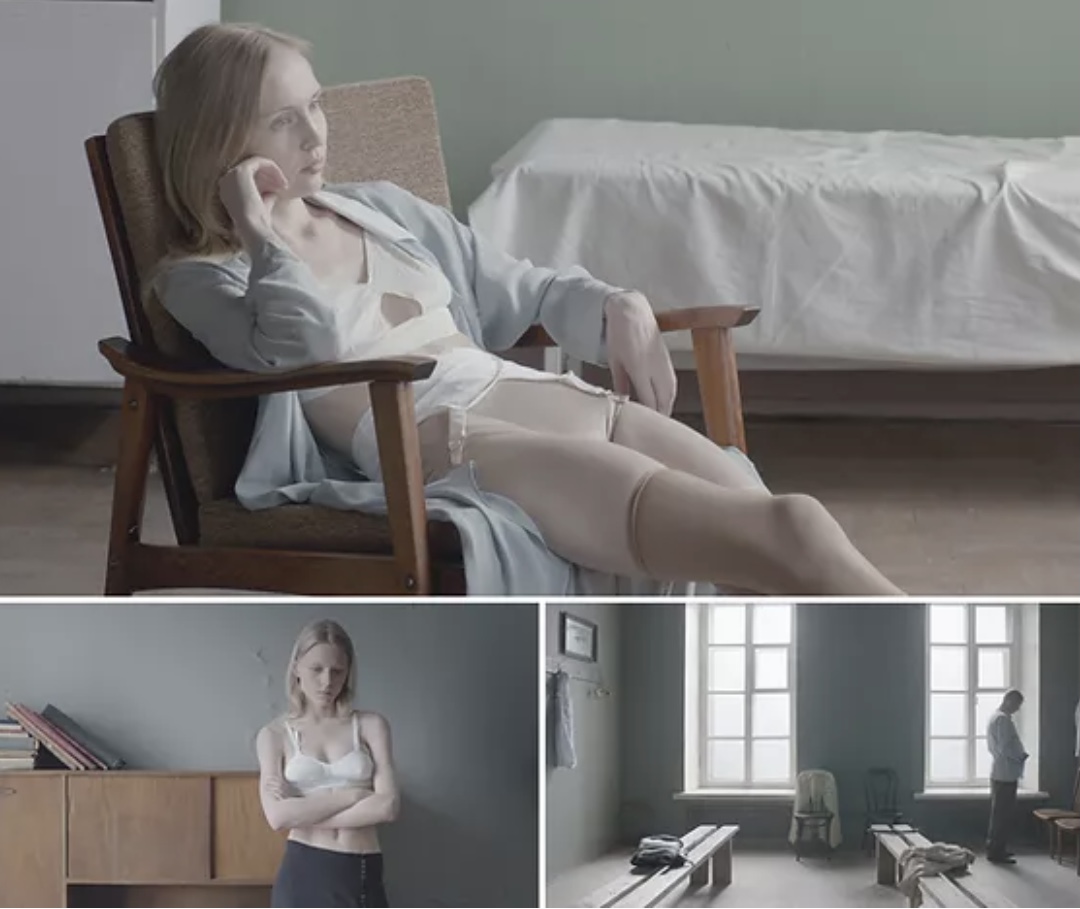</The Origins Of Russian Video Art. In III parts>
author: Milena Poluyakhtova

PART I. Andrei Monastyrski, The Pirate TV, zAiBi
Due to the strict political regime of the Soviet Union, video art emerged in Russia only in the late 80s and early 90s, unlike in Europe and the United States, where video art began to blossom in the mid-1960s. Russian video art is mostly defined by narrativity as a characteristic that is based on a storyline. The Moscow conceptualists pioneered video art in Russia as they wanted to tell stories to viewers through their actions that they documented on camera.
The Moscow Conceptualism artistic movement first emerged in the 1970s and was originated by such acclaimed artists as Ilya Kabakov, Viktor Pivovarov and Andrei Monastyrski. The movement was initially of a clandestine and unofficial nature as it had to exist during the strict Soviet regime, which tried to dictate what kind of art should be produced. The Moscow Conceptualists attempted to create their own narrative that would be understandable only to the like-minded people and would be different from the mainstream Soviet art at the time. The artists aimed to highlight human subjectivity and visual bonds by putting an emphasis on creating conversations, a dialogue, rather than just an art object. The movement’s works are often accompanied by a text or even a long text message drawn on a painting or any other media.
The Moscow Conceptualism artistic movement first emerged in the 1970s and was originated by such acclaimed artists as Ilya Kabakov, Viktor Pivovarov and Andrei Monastyrski. The movement was initially of a clandestine and unofficial nature as it had to exist during the strict Soviet regime, which tried to dictate what kind of art should be produced. The Moscow Conceptualists attempted to create their own narrative that would be understandable only to the like-minded people and would be different from the mainstream Soviet art at the time. The artists aimed to highlight human subjectivity and visual bonds by putting an emphasis on creating conversations, a dialogue, rather than just an art object. The movement’s works are often accompanied by a text or even a long text message drawn on a painting or any other media.
In 1985, video became the new media for Moscow conceptualists to explore, when German curator Sabine Hänsgen arrived in the USSR to film the performances and creative process of the Collective Actions artistic group, founded by Monastryski. Andrei took Sabina’s camera and made the first video artwork 'Conversation with the lamp'.
Throughout the video, he talked about how uncomfortable he was in front of the camera. He tried to realize what was in front of him by creating direct dialogue with the camera. After a while, the artist started to draw on his body. At the end of the video, he showed a lamp, that was behind the camera throughout the video. The viewer understands why the video is called 'Conversation with the lamp'.
After a while, the Collective Actions started to document their activities and as a result, video was integrated into their performative practices. That became an important milestone for video art in Russia.
The first public exhibition of video installations took place in the USSR in 1990, in Kazan, and in 1993 in Moscow. Bulat Galeev (1940-2009), the master of visual music, who was one of the pioneers of media art, took a huge part in making this happen. The first video installations were created under his artistic supervision by the students of design bureau Prometheus at the Kazan Aviation Institute. The bureau was responsible for the country's first large-scale light concerts, created abstract light and music films. The emergence of new technology made it possible to switch from organizationally painful cinema experiments to abstract light and music videos.
Until the late 1980s, Soviet television was more an ideological instrument of politics and functioned within a rigid framework. However, the beginning of the 90s – the time of the dissolution of the Soviet Union – was the time of democratization of society and television broadcasting. In Russia, alternative TV took the form of dissent and free expression of artists.
The first public exhibition of video installations took place in the USSR in 1990, in Kazan, and in 1993 in Moscow. Bulat Galeev (1940-2009), the master of visual music, who was one of the pioneers of media art, took a huge part in making this happen. The first video installations were created under his artistic supervision by the students of design bureau Prometheus at the Kazan Aviation Institute. The bureau was responsible for the country's first large-scale light concerts, created abstract light and music films. The emergence of new technology made it possible to switch from organizationally painful cinema experiments to abstract light and music videos.
Until the late 1980s, Soviet television was more an ideological instrument of politics and functioned within a rigid framework. However, the beginning of the 90s – the time of the dissolution of the Soviet Union – was the time of democratization of society and television broadcasting. In Russia, alternative TV took the form of dissent and free expression of artists.
The most striking manifestation of alternative television was the project called 'The Pirate TV' (1989-1992) and created by Juris Lesnik, Vladik Mamychev-Monroe, Timur Novikov, and Moscow correspondent Sergey Shutov.
The main idea of this project was to create the TV-like program presented as a model of false television. For example, they created sports news, a parody of advertisements. It imitated the state-run television programs, but unlike real TV programs, 'The Pirate TV' existed only on videotapes and has never been broadcast.

The Pirate TV, Juris Lesnik, Vladik Mamychev-Monroe, Timur Novikov and Sergey Shutov / MediaArtLab, link
Sergey Shutov, one of the pioneers of Russian video art, experimented with technologies. He created a series of video remixes of popular Soviet films 'Look at the silence' (the movie 'Heavenly Slow') and 'The Secret of Two Oceans 2',1992 (the movie 'The Secret of Two Oceans'), where he mixed both video and sound montage. Through a combination of video fragments, image transformation and rhythm changes, the artist created a new composition of the story, destroying the old one.
Another part of the development of video art in Russia can be experimentation with video animations. 'Sunrise', 'Submarine', 'Penguins', 'Airplane' (1993) – video animations by Timur Novikov and Sergey Shutov. These video artworks are animated textile applications by Timur Novikov. Video animations were made in a minimalistic way.
Another part of the development of video art in Russia can be experimentation with video animations. 'Sunrise', 'Submarine', 'Penguins', 'Airplane' (1993) – video animations by Timur Novikov and Sergey Shutov. These video artworks are animated textile applications by Timur Novikov. Video animations were made in a minimalistic way.
Another example of experimenting with video animation is the micro-fairy tales of the zAiBi art group.
zAiBi – an acronym for the phrase 'for anonymous and free art' in the Russian language – is an art group that existed from 1990 to 2000 in Moscow. The main activities of the group were carrying out art actions and videos. The video animation 'Lenin and Stalin', consisting of three parts (1991-1998; 1998; 2000), is a tale about two Russian leaders – Lenin and Stalin. The geometric figures represented the characters of this story.
Watch on YouTube
zAiBi – an acronym for the phrase 'for anonymous and free art' in the Russian language – is an art group that existed from 1990 to 2000 in Moscow. The main activities of the group were carrying out art actions and videos. The video animation 'Lenin and Stalin', consisting of three parts (1991-1998; 1998; 2000), is a tale about two Russian leaders – Lenin and Stalin. The geometric figures represented the characters of this story.
Watch on YouTube
The freedom that Russian artists received after the collapse of the Soviet Union became a factor in the emergence of activity in experiments with technology, including the emergence of alternative television, and freedom of artists’ action. Basically, the camera acted as a documentary device. Russian video artists have focused on storytelling, creating and telling stories and documenting their actions. Thus, cameras among Russian artists became a part of their creative practice.
Sources:
Sources:
PART II. AES+F, Bluesoup, Provmyza
The AES group was formed in 1987 by Tatiana Arzamasova (b. 1955), Lev Evzovich (b. 1958), and Evgeny Svyatsky (b. 1957), and named after the first letters of their last names. In 1995, Vladimir Fridkes (b. 1956) joined and the art group was renamed to AES+F.
Their first artworks attempted to criticize society and human behavior. For example, Who wants it forever (1998) reprimands media over obsession with sex scandals and celebrity deaths. In this video, a woman is posing in a dress and make-up, but she has bruises and blood over her face and body.
Their first artworks attempted to criticize society and human behavior. For example, Who wants it forever (1998) reprimands media over obsession with sex scandals and celebrity deaths. In this video, a woman is posing in a dress and make-up, but she has bruises and blood over her face and body.

AES+F, The feast of Trimalchio, 2009-2010
Since 2005, the art group’s style has changed: they are interested in creating a virtual space, a fantasy world based on modernity but filled with references to iconography, allegories, and plots of classical art. Artists use variegated bright colors and create an image of people that looks more virtual than real. Sometimes the motions in the video glitch on purpose to enhance the feeling of virtual reality.
The Luminal Space Trilogy consists of three video artworks: Last Riot (2005-2007), The Feast of Trimalchio (2009-2010), and Allegoria Sacra (2011-2013). In the Last Riot, artists have created a new mutated world in which people, participants in the rebellion, fight with themselves and with others. In this artwork, the war between genderless angel-like creatures breaks out in a virtual fantasy landscape.
In The Feast of Trimalchio, the artists took the image of Trimalchio — a former slave who got rich on speculation — from “Satyricon,” a novel believed to have been written by Gaius Petronius.
The Luminal Space Trilogy consists of three video artworks: Last Riot (2005-2007), The Feast of Trimalchio (2009-2010), and Allegoria Sacra (2011-2013). In the Last Riot, artists have created a new mutated world in which people, participants in the rebellion, fight with themselves and with others. In this artwork, the war between genderless angel-like creatures breaks out in a virtual fantasy landscape.
In The Feast of Trimalchio, the artists took the image of Trimalchio — a former slave who got rich on speculation — from “Satyricon,” a novel believed to have been written by Gaius Petronius.
As Trimalchio’s name has become synonymous with decadent lifestyle and gluttony, AES+F has decided to depict the character not as an individual, but as a collective image of a luxurious hotel, where guests engage in a gastronomic and erotic orgy and are being pampered by “servants.” However, “the paradise” will not last long and ultimately would be crashed by a catastrophe.
Allegoria Sacra, the last part of the trilogy, references Giovanni Bellini’s painting of the same name, which has always been a mystery of interpretation for art historians. AES+F thought that the place depicted on the painting was purgatory, where souls await their fate. The group has come up with a modern interpretation of this painting. In their work, the scene takes place at the airport, which serves as purgatory. Thus, they combined Bellini’s metaphorical heroes and the image of modern-day people from various countries and cultures.
Allegoria Sacra, the last part of the trilogy, references Giovanni Bellini’s painting of the same name, which has always been a mystery of interpretation for art historians. AES+F thought that the place depicted on the painting was purgatory, where souls await their fate. The group has come up with a modern interpretation of this painting. In their work, the scene takes place at the airport, which serves as purgatory. Thus, they combined Bellini’s metaphorical heroes and the image of modern-day people from various countries and cultures.
Bluesoup Group is the art group that was created in 1996 by Daniil Lebedev (b.1974), Alexey Bobrov (b.1975), Valery Patkonen (b.1972), Alexander Lobanov (b.1975) joined in 2002. In 2010, Patkonen left the art group.
Their early videos are characterized by an ironic perception of reality. Artists perceived the creation of their video works as a joke. One of their first works — Camouflage (1997) — parodies the cinema. In the video, people are executed by blue pellicle. But after being shot, the victims come back to life and tear off blue pellicle, as a metaphor for identity change.
After 2005, the art group turned to building landscapes or interiors. Their following video works became more cinematic, but devoid of narration. The artists rejected the narrative and focused on the symbolic imaginary based on monotony of action and monotony of scenes.One of their trilogies, consisting of Echelon (2006), Lake (2007) and Defense (2007), demonstrates it.
Pics: (1) Bluesoup Group, Defense, 2007, (2) Bluesoup Group, Lake, 2007.
Their early videos are characterized by an ironic perception of reality. Artists perceived the creation of their video works as a joke. One of their first works — Camouflage (1997) — parodies the cinema. In the video, people are executed by blue pellicle. But after being shot, the victims come back to life and tear off blue pellicle, as a metaphor for identity change.
After 2005, the art group turned to building landscapes or interiors. Their following video works became more cinematic, but devoid of narration. The artists rejected the narrative and focused on the symbolic imaginary based on monotony of action and monotony of scenes.One of their trilogies, consisting of Echelon (2006), Lake (2007) and Defense (2007), demonstrates it.
Pics: (1) Bluesoup Group, Defense, 2007, (2) Bluesoup Group, Lake, 2007.
In Echelon, endless trains are depicted carrying unidentified cargo under the rain and snow. In the video artwork Lake, nothing happens except for a change in lighting over the lake. Defense shows a foggy mystical swamp, a metaphysical landscape exuding an uncomfortable feeling.
All three videos show an artificial computer-generated scenery. The image in each video is as close as possible to reality, but at the same time, it is abstract and oozes a feeling of understatement.
Since 2016 artists have focused on the 3D image. For example, in the video work Cascade (2016), a fluid that appears to be water or mercury slowly descends the stairs and nears the viewer’s feet.
Pics: (1) Bluesoup Group, Cascade, 2016, (2) Bluesoup Group, Echelon, 2006, (3) Bluesoup Group, Camouflage, 1997.
All three videos show an artificial computer-generated scenery. The image in each video is as close as possible to reality, but at the same time, it is abstract and oozes a feeling of understatement.
Since 2016 artists have focused on the 3D image. For example, in the video work Cascade (2016), a fluid that appears to be water or mercury slowly descends the stairs and nears the viewer’s feet.
Pics: (1) Bluesoup Group, Cascade, 2016, (2) Bluesoup Group, Echelon, 2006, (3) Bluesoup Group, Camouflage, 1997.
Provmyza is an art group officially formed in 1998 by Galina Myznikova (b. 1968) and Sergey Provorov (b.1970).
Their first work Line structure (1994) is an animation that was inspired by Russian constructivism and suprematism. The artists focused on the deformation of lines on the screen. In 1998, they created an artwork called Miss Ragozina as a metronome (1998), which shows monotonous actions that a housewife usually does. Tension emanates from repetitive tiresome movements.
Their first work Line structure (1994) is an animation that was inspired by Russian constructivism and suprematism. The artists focused on the deformation of lines on the screen. In 1998, they created an artwork called Miss Ragozina as a metronome (1998), which shows monotonous actions that a housewife usually does. Tension emanates from repetitive tiresome movements.
Their first work Line structure (1994) is an animation that was inspired by Russian constructivism and suprematism. The artists focused on the deformation of lines on the screen. In 1998, they created an artwork called Miss Ragozina as a metronome (1998), which shows monotonous actions that a housewife usually does. Tension emanates from repetitive tiresome movements.

Provmyza, Wet chicken, 2003
In their artworks, Provmyza often uses poetry and metaphors from everyday life. They touch upon the themes of how modern media incites violence (Wet chicken, 2003), the power of media technologies (Alternative play station, 2004), or the influence of advertisement (The Girl - Helicopter, 2004). Their creations capture ordinary scenes, where the deceitfulness of media is subsequently debunked.
In Three Sisters (2006) — based on the play by the Russian writer Anton Chekhov — the group attempts to highlight that any decision leads to serious consequences. The video features a theatrical performance where three children play and are constantly faced with choices.

Provmyza, Three Sisters, 2006

Provmyza, Pitter Patter, 2009
In the Pitter Patter (2009), they took a plot scene from photographs by English photographer Henry Peach Robinson and recreated it in the video. In this piece, a dying girl is lying on a bed surrounded by a crowd of people. The scene is full of lyricism, which Provmyz believes has been lost in contemporary art.
Over time, their artworks began to acquire narrative. However, they do not have the literary and verbal features of cinema. Their work is minimalistic, poetic, and filled with symbolism. One of their latest works Oratorium Sarxsoma (2020) is a theatrical performance recorded on camera and divided into 11 plots-metaphors. The theme of the artwork is loss, different modes of feeling, and experiencing tragic events.

Provmyza, Oratorium Sarxsoma, 2020
PART III.Taus Makhacheva, Polina Kanis
Taus Makhacheva was born in 1983 in Moscow. She creates video art as her own metaphorical performance, often associated with the cultural traditions and social problems of Russia’s Republic of Dagestan, where her family comes from, including her grandfather, an acclaimed poet Rasul Gamzatov.
Makhacheva has studied in the United Kingdom and in 2013 received a Master's degree in Contemporary Art from Royal College of Art in London. She has achieved worldwide recognition and is a recipient of numerous awards, including the Kandinsky Prize, while her works are in the collections of Louis Vuitton Foundation, the Los Angeles County Museum of Art and Tate Modern, among many others.

Fast and furious, 2011
In “Fast and furious”, 2011, Taus was inspired by street racing subculture. In the video, the artist filmed Dagestan men being mesmerized by a car that was decorated by fur, which makes it look like a wild animal. When the artist was working on the video, she wondered if it was possible to get rid of ideological and imposed media images. The artist chose the culture of street racers, in which the technical condition and tuning of the car has become the measure of masculinity. When Taus put this car on display, it has made quite an impression on the men of this closed society.
“Bullet", 2010. In the video, Makhacheva shoots a pistol into the sand, and then tries to find the bullet, as if she is performing some kind of ritual to free herself from aggression. This artwork is based on a tragic story that happened on the corner of the artist's house in Makhachkala, when three policemen and several children have been killed. “Bullet” digs into essence of violence and how to heal from it.

Bullet, 2010

Super Taus
In the video "Super Taus", the alter ego of the artist — a philologist working in kindergarten — appeared for the first time. The video was filmed on a dash cam. The car stops because of a large stone on the road. Three workers were unable to do anything, but Super Taus got out of the car and removed the stone with ease. The artist wanted to make a viral video that, having circulated on the Internet, would someday return to her in a message.
"Tightrope", 2015. In the video, a man, who is a 5th generation tightrope walker, walks on a rope across a mountain canyon, dragging paintings and putting them on shelves for storage. 61 copies of artworks were selected, one by each Dagestan artist from the collection of the Dagestan Museum of Fine Arts named after Patimat Gamzatova, Makhacheva’s grandmother. This video-performance is about the invisible history of regional art. The artist wanted to highlight the problem of regional museums often not getting the attention they deserve, even though they host magnificent works of art created by local artisans.

Tightrope, 2015

Baida, 2017
"Baida", 2017, is named after an old boat from Dagestan used by fishermen and poachers in the Caspian Sea. The boat was supposed to be transported from the Caspian Sea to the open waters of Adriatic Sea for the 57th Venice Biennale. Visitors were able to find it by using geocode. In the video, researchers are trying to find this boat with people on board,but they have found the boat upside down. Researchers do not understand whether this boat is the same, whether anyone has drowned. “Baida” reflects the fragility of human life as fishermen often roll over under storm and sometimes they even tie themselves to the bow of the boat so that if an accident happens, the body can be found.

Purification, 2010
Polina Kanis — born in 1985 in Leningrad (now St.Petersburg) — is an acclaimed Russian video artist and a recipient of the prestigious Kandinsky Prize. Her solo exhibitions have been held in Amsterdam, Berlin and Turin.
“Purification”, 2010. In the video, men with a bucket of water take turns sitting in front of a girl, who should wash men’s feet. The role of the girl was played by the artist herself. All people in the scene are dressed in white T-shirts and shorts, uniform underwear that does not bear signs of home comfort. Here, the artist is trying to bring the mechanical movement into her action, and we can see the absence of an emotional component.
“Purification”, 2010. In the video, men with a bucket of water take turns sitting in front of a girl, who should wash men’s feet. The role of the girl was played by the artist herself. All people in the scene are dressed in white T-shirts and shorts, uniform underwear that does not bear signs of home comfort. Here, the artist is trying to bring the mechanical movement into her action, and we can see the absence of an emotional component.
"Eggs", 2010 In this video, the artist on the roof of the house catches falling eggs with her skirt, like the old Soviet electronic game "Nu, Pogodi!", where the wolf catches eggs. The work reflects on the gender status of the individual as part of the social structure and also shows the main character’s perseverance even though she fails to catch an egg. The artist herself used to play this game, but the idea came when she saw a guy playing it.

Eggs, 2010

Workout, 2011
“Workout”, 2011. The artist took on the role of a fitness instructor who works out with the elderly people in a park and as some fitness gurus tend to do, is behaving extremely totalitarian. It shows power relations of higher straits of society. The elderly willingly obey and listen to instructions with delight.
”New flag”, 2014. The project consists of two parts: a video and a photo. In the video, the girl was trying to sit on a horse, but she could not. The video shows that the teachers were negligent in the lessons, although they were being paid. However, in the photo she is sitting on the horse defiantly raising a flag. In the exposition, the photograph stood next to the video. The project is about a way to overcome and glorify the heroism and perseverance of this girl. The hero is not the one who immediately gets on a horse, but the one who tries and never gives up.

New flag, 2014

The shift, 2016
”The shift”, 2016. In the video, a janitor is cleaning rooms in an American brothel (filmed in the building of a former museum). When he walks into the last room, he finds that a performance is being rehearsed.
“The Procedure“, 2017. A Three-part video installation. In the first video, the action takes place indoors, on the second one a guy walks through the forest, on the third, the same guy sits motionless, gets up and shows his bare torso. The voice says "I didn't see anything". The exposition used rear projection, when the projector shines from the other side of the screen, and the viewer can come close to the screen without blocking the image. Thus, the tension between looking at and being in the space increases so that the image itself becomes sculptural. This video is set in the aftermath of a disaster that is not shown, but the feeling of the aftermath is conveyed through intense cinematic footage.

The Procedure, 2017




